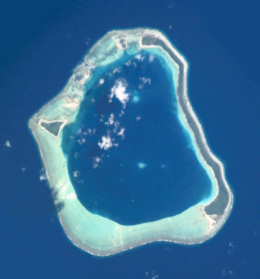Maupihaa

NASA picture of the island of Maupihaa Atoll.
|
|
 |
|
| Geography | |
|---|---|
| Location | Pacific Ocean pito |
| Coordinates | 16°48′S 153°57′W / 16.800°S 153.950°WCoordinates: 16°48′S 153°57′W / 16.800°S 153.950°W |
| Archipelago | Society Islands |
| Area | 2.6 km2 (1.0 sq mi) |
| Administration | |
|
France
|
|
| Overseas collectivity | French Polynesia |
| Administrative subdivision | Leeward Islands |
| Demographics | |
| Population | 10 (1985) |
| Pop. density | 4 /km2 (10 /sq mi) |
Maupihaa, also known as Mopelia, is an atoll in the Leeward group (Iles sous le Vent) of the Society Islands. This atoll is located 72 km southeast of Manuae, its nearest neighbor.
Maupihaa atoll is roughly 8 km in length and contains a lagoon that is up to 40 m in depth and is surrounded by submerged reefs on three sides. The atoll's outer reefs are continuous except for a small passage on the western side of the atoll. The eastern side consists of a narrow, thickly vegetated, islet (Motu Maupihaa) and a number of smaller islets bring the total land area of Maupihaa to 2.6 km². The only village on the atoll is located on Motu Maupihaa and as of 1985, the population consisted of just 10 people.
Maupihaa Atoll was inhabited in very ancient times by Polynesians; archaeological remains and fish hooks have been found. The first European to arrive on Maupihaa, along with neighboring Fenua Ura and Motu One, was Samuel Wallis in 1767. In 1917, the atoll was leased to a Papeete company, with three employees producing copra, and raising pigs and chickens and collecting turtles. It was later leased to another copra company and entirely planted with coconut palms.
In the same year, Count Felix von Luckner of the famed SMS Seeadler visited the island and established a small colony during his voyage to raid Allied shipping in the South Pacific during the First World War. The purpose of the stop was to obtain water and fresh stores and to make repairs to the Seeadler's hull after a long journey through the Atlantic Ocean and around South America. Since SMS Seeadler was too large to enter Mopelia lagoon, she was anchored on the outside of the atoll. After a short time, rough seas and wind caused the Seeadler to run aground on Mopelia's reef, leaving Luckner and about 50 others marooned. In Lowell Thomas' 1928 book on von Luckner he reports that the loss of Seeadler was the consequence of a tsunami.
...
Wikipedia
